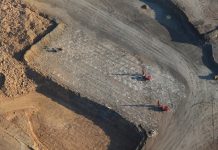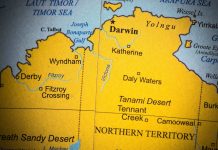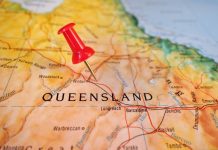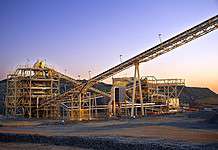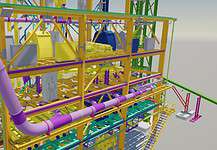SPANNING more than 7 million square kilometres, Australia is famous for its remoteness: 18 per cent of the country is classified as arid desert, and a further 44 per cent is classified as dry grassland.
Australia is highly urbanised, with the majority of the population settled within the more temperate climates of the southeast and southwest coasts.
In recent years however, Australia’s populace has become more rural, with people moving to the previously less-inhabited areas of the red centre and far north to live and work. This interesting migration pattern is thought to owe particularly – perhaps exclusively – to the rise of the resources industry.
Resources and regional Australia The resources industry is recognised for its intrinsically hazardous nature: its workforce is often required to complete such risky activities as the operation and control of heavy machinery, entering underground mining shafts for the removal of ore, or working with caustic chemicals during ore processing.
Preventative medicine and training are the primary strategies used by the sector to maximise employee safety, with significant funds invested in occupational health and safety initiatives. Despite these efforts, however, workplace accidents and health issues remain an ongoing issue.
Enter the Royal Flying Doctor Service (RFDS) of Australia: one of world’s largest and most comprehensive aero-medical organisations. Colloquially known as The Flying Doctors, the not-for-profit organisation provides hospital and medical services to regional, rural and remote locations across the country where such services are otherwise limited.
The organisation is also of integral importance to the resources industry, providing emergency and primary health care services to regional mining and energy-based hubs and communities. John Flynn and the history of Australia’s RFDS
The RFDS was conceived by Australian Presbyterian minister Reverend John Flynn and initiated after a year-long experiment called the Aerial Medical Service in Cloncurry, Queensland. The organisation was officially established on 15 May 1928 and celebrates its 85th birthday this year.
Reverend Flynn’s initial stimulus for the flying doctors service began during his early career. Working as a missionary setting up hospitals in rural Victoria he witnessed the frustrating medical obstacles regional workers often faced due to the vast regional landscape where medical care only extended to about one doctor per million square kilometres.
During public speeches, Reverend Flynn often retold stories of befallen bush settlers he had known and heard of in his missionary work, including that of the now famous story of Jimmy Darcy, a regional stockman who died following work-related injuries in 1917.
Darcy worked at Ruby Plains, a remote cattle station in the Kimberley in northern WA. After being found on the station with a ruptured bladder, he was transported over a 12 hour period to the nearest town, Halls Creek. There, he was met by FW Tuckett, the post office master, and the only man in the settlement trained in first aid. However, the postmaster was certain there was nothing he could do for the serious injuries, and tried unsuccessfully to telegraph doctors in Wyndham and Derby.
Eventually, a doctor in Perth guided Tuckett through two bladder operations via Morse code, with the only instrument available, a pen knife. Due to the total absence of any medical facilities, Darcy had to be strapped to the post office counter and inebriated with whisky.
Following the operation, the Perth-based doctor travelled 10 days to Halls Creek, only to find that Darcy had died the day before. To add to the tragedy, Tuckett’s operation had been successful, but Darcy was declared to have died from an undiagnosed case of malaria and a burst abscess in his appendix.
Through such stories, Reverend Flynn appealed to the public for ideas for a route of communication that could provide medical help to those in isolated rural areas.
Reverend Flynn was given the idea of creating a flying doctor’s service via his communication with a Victorian lieutenant who had heard the minister’s public speeches. Before being deployed to fight in the First World War, Lt Clifford Peel wrote to the reverend, describing how he had previously seen a missionary doctor visiting isolated patients using an aeroplane. Lt Peel was killed in combat during the war, but his letter prior to his departure provided the basis for Reverend Flynn’s subsequent life work.
By 1934, the Aerial Medical Service had become an Australia-wide operation. The public face of the organisation and central lobbyist for its financial survival, John Flynn receives ongoing honour for his establishment of this integra organisation, with his likeness featured on one side of the current Australian 20 dollar note.
Reverend Flynn died of cancer in 1951; four years later, the Flying Doctor Service was granted the title of Royal by Queen Elizabeth II.
The RFDS today
The success of the RFDS and its fundamental role in society is evident through its growth: divided into seven subsidiary entities the RFDS provides widespread cover across all states and territories, using the latest technologies in aviation, medicine and communications. The RFDS also works to provide assistance to urban centres, transporting patients from congested city hospitals to quieter, rural medical centres.
Nick Harvey, a general manager at the Western Operations division of the Royal Flying Doctor Service, said the organisation had grown from humble beginnings.
“Until the 1960s, the service rarely owned its own aircraft, but used contractors to provide aircraft, pilots and engineers,” he said.
“Today, 85 years later, the RFDS is the most comprehensive aeromedical organisation in the world, with 61 aircraft, 21 bases and 1000 staff Australia-wide.
“RFDS’s fleet is the fourth largest air fleet in Australia [behind only commercial airlines, Qantas Group, Virgin Group and Cobham Group].”
The RFDS of Australia’s seven subsidiaries maintain complete independence, both financially and operationally. They include the National Office, Central Operations, Queensland Section, South Eastern Section, Tasmania, Victoria and Western Operations, and all hold several bases in their specified operating area.
Western Operations
RFDS’ Western Operations has sustained significant pressure increases on its resources, since the expansion of the mining and energy industries between 10 and 15 years ago.
“The challenge for the RFDS in WA has been in keeping up with the rapid increase in demand for our aeromedical and primary health care services, as the resources and associated sectors fuel our population expansion in regional hub and communities in the state’s North West regions,” Mr Harvey said.
“Our state-wide emergency call centre last year received more than 35,000 calls for medical assistance and advice. Never before in our history has the footprint and the reach of the RFDS been larger across the state. To ensure we are able to deliver life-saving services to the furthest corners of our state, we have to continually expand our reach and capabilities.”
Western Operations operates five bases throughout WA, at Jandakot, Kalgoorlie, Meekatharra, Derby and Port Hedland. In response to the resources boom and a realignment of the Health Department’s regional hub in the North West, Western Operations is now working toward opening a sixth base in Broome.
“In the last five years, RFDS patient transportations to Broome have increased by a staggering 236 per cent. Broome is now our busiest patient transport hub in the north of the state, with over 600 patients moved to and from the destination last year,” Mr Harvey said.
“We are looking to establish a new base in Broome, to better meet demand; however, this comes at a price. Establishing a new base will cost approximately $20 million, and is entirely dependent on funding support received from government, corporates and fundraising from the community.”
In recognition of the service the Western Operations performs for the resources industry within WA, the organisation has received generous funding from leading resource sector businesses including Rio Tinto, BHP Billiton, Woodside and Chevron. Despite these contributions, Western Operations recorded an operating deficit of $800,000 in 2011 to 2012, mostly due to patient transportation expenses.
With the building of the Broome RFDS base Western Operations aims to level its balance into the future. RFDS in 2013 and beyond Across 2011 to 2012, RFDS clocked up significant figures per day: 72,870km of air travel; 750 patient contacts and 112 transported patients, including primary evacuations, inter-hospital transfers, transports from clinics, repatriations and road transports.
Based on these figures, Mr Harvey projected continuing growth for the organisation, while maintaining a central view of the organisation’s ethos.
“It is our mission to provide the finest care to the furthest corners of our country,” he said.
“It is the spirit of John Flynn’s vision to provide a ‘mantle of safety’; that motivates us to continue his entrusted legacy of our past 85 years, ensuring that we continue to provide relevant and contemporary services, and expand our life-saving case as our state continues to grow and prosper.”

